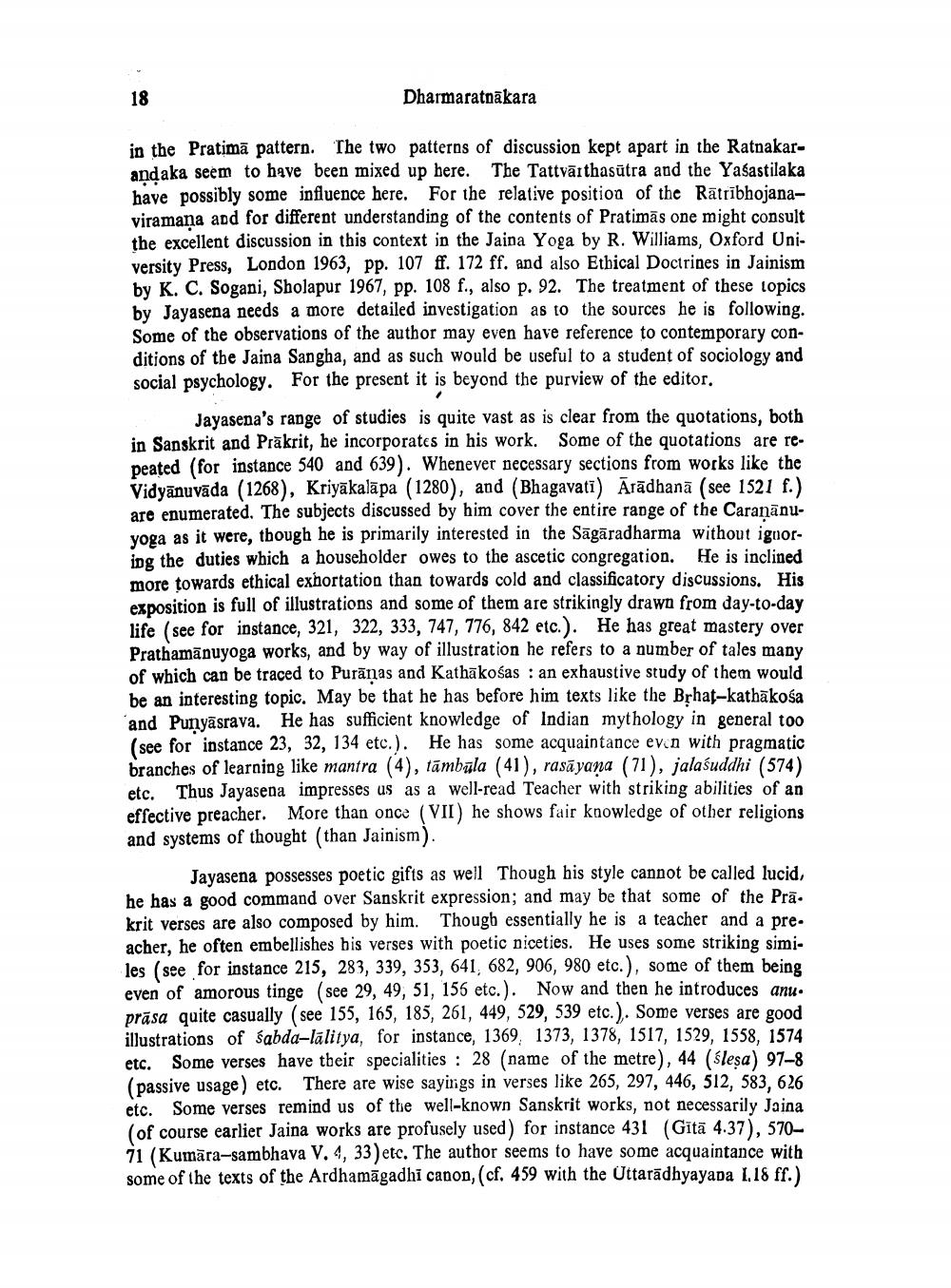________________
Dharmaratnākara
in the Pratimā pattern. The two patterns of discussion kept apart in the Ratnakarandaka seem to have been mixed up bere. The Tattvāıthasūtra and the Yašastilaka have possibly some influence here. For the relative position of the Rātrībhojanaviramana and for different understanding of the contents of Pratimas one might consult the excellent discussion in this context in the Jaina Yoga by R. Williams, Oxford University Press, London 1963, pp. 107 ff. 172 ff. and also Ethical Doctrines in Jainism by K. C. Sogani, Sholapur 1967, pp. 108 f., also p. 92. The treatment of these topics by Jayasena needs a more detailed investigation as to the sources he is following. Some of the observations of the author may even have reference to contemporary conditions of the Jaina Sangha, and as such would be useful to a student of sociology and social psychology. For the present it is beyond the purview of the editor.
Jayasena's range of studies is quite vast as is clear from the quotations, both in Sanskrit and Prākrit, he incorporates in his work. Some of the quotations are repeated (for instance 540 and 639). Whenever necessary sections from works like the Vidyānuvāda (1268), Kriyākalāpa (1280), and (Bhagavatī) Ārādhanā (see 1521 f.) are enumerated. The subjects discussed by him cover the entire range of the Caraṇānuyoga as it were, though he is primarily interested in the Sāgāradharma without ignoring the duties which a householder owes to the ascetic congregation. He is inclined more towards ethical exhortation than towards cold and classificatory discussions. His exposition is full of illustrations and some of them are strikingly drawn from day-to-day life see for instance, 321, 322, 333, 747, 776, 842 etc.. He has great mastery over Prathamānuyoga works, and by way of illustration he refers to a number of tales many of which can be traced to Puranas and Kathākośas : an exhaustive study of them would be an interesting topic. May be that he has before him texts like the Brhat-kathākoša and Punyāsrava. He has sufficient knowledge of Indian mythology in general too (see for instance 23, 32, 134 etc.). He has some acquaintance even with pragmatic branches of learning like mantra (4), tāmbūla (41), rasāyana (71), jalaśuddhi (574) etc. Thus Jayasena impresses us as a well-read Teacher with striking abilities of an effective preacher. More than once (VII) he shows fair knowledge of other religions and systems of thought (than Jainism).
Jayasena possesses poetic gifts as well Though his style cannot be called lucid, he has a good command over Sanskrit expression, and may be that some of the Prā. krit verses are also composed by him. Though essentially he is a teacher and a pre. acher, he often embellishes his verses with poetic niceties. He uses some striking similes (see for instance 215, 283, 339, 353, 641, 682, 906, 980 etc.), some of them being even of amorous tinge (see 29, 49, 51, 155 etc.). Now and then he introduces anu. prāsa quite casually see 155, 165, 185, 261, 449, 529, 539 etc.). Some verses are good illustrations of sabda-lalitya, for instance, 1369, 1373, 1378, 1517, 1529, 1558, 1574 etc. Some verses have their specialities : 28 (name of the metre), 44 (ślesa) 97-8 (passive usage) etc. There are wise sayings in verses like 265, 297, 446, 512, 583, 626 etc. Some verses remind us of the well-known Sanskrit works, not necessarily Jaina (of course earlier Jaina works are profusely used) for instance 431 (Gītā 4.37), 57071 (Kumāra-sambhava V. 4, 33) etc. The author seems to have some acquaintance with some of the texts of the Ardhamāgadhi canon, (cf. 459 with the Uttarādhyayapa 1.18 ff.)




